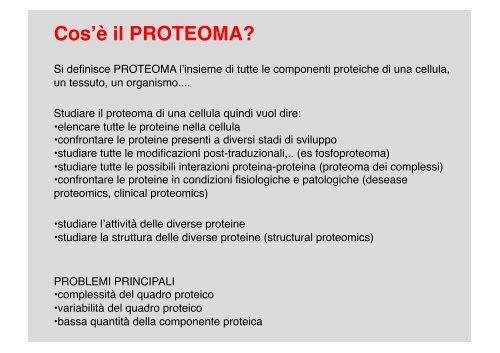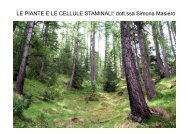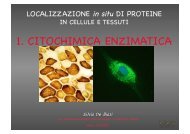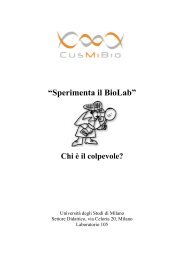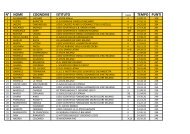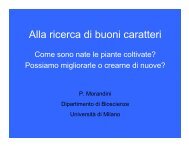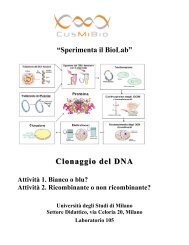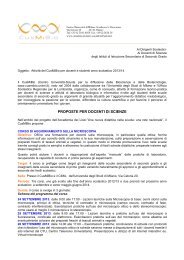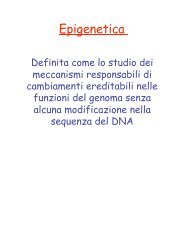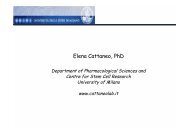Proteomica - CusMiBio - Università degli Studi di Milano
Proteomica - CusMiBio - Università degli Studi di Milano
Proteomica - CusMiBio - Università degli Studi di Milano
- No tags were found...
You also want an ePaper? Increase the reach of your titles
YUMPU automatically turns print PDFs into web optimized ePapers that Google loves.
Cos’è il PROTEOMA!<br />
Si definisce PROTEOMA l’insieme <strong>di</strong> tutte le componenti proteiche <strong>di</strong> una cellula,<br />
un tessuto, un organismo....!<br />
<strong>Stu<strong>di</strong></strong>are il proteoma <strong>di</strong> una cellula quin<strong>di</strong> vuol <strong>di</strong>re:!<br />
• elencare tutte le proteine nella cellula!<br />
• confrontare le proteine presenti a <strong>di</strong>versi sta<strong>di</strong> <strong>di</strong> sviluppo!<br />
• stu<strong>di</strong>are tutte le mo<strong>di</strong>ficazioni post-traduzionali,.. (es fosfoproteoma)!<br />
• stu<strong>di</strong>are tutte le possibili interazioni proteina-proteina (proteoma dei complessi)!<br />
• confrontare le proteine in con<strong>di</strong>zioni fisiologiche e patologiche (desease<br />
proteomics, clinical proteomics)!<br />
• stu<strong>di</strong>are l’attività delle <strong>di</strong>verse proteine!<br />
• stu<strong>di</strong>are la struttura delle <strong>di</strong>verse proteine (structural proteomics) !<br />
PROBLEMI PRINCIPALI!<br />
• complessità del quadro proteico!<br />
• variabilità del quadro proteico!<br />
• bassa quantità della componente proteica!
Componenti molecolari <strong>di</strong> una !<br />
cellula <strong>di</strong> Escherichia coli!<br />
Percento approssimato Numero approssimato!<br />
del peso totale <strong>di</strong> specie molecolari !<br />
della cellula<br />
<strong>di</strong>verse!<br />
Acqua 70 1 !<br />
Proteine 15 3000!<br />
Aci<strong>di</strong> nucleici!<br />
DNA 1 1!<br />
RNA 6 >3000!<br />
Polisaccari<strong>di</strong> 3 5!<br />
Lipi<strong>di</strong> 2 20!<br />
Subunità!<br />
monomeriche e!<br />
Interme<strong>di</strong> 2 500!<br />
Ioni inorganici 1 20 !
B. LEWIN, IL GENE - E<strong>di</strong>zione<br />
compatta, Zanichelli E<strong>di</strong>tore S.p.A.<br />
Copyright © 2007
- Il proteoma è molto + complesso del genoma. Ad esempio<br />
1 gene può co<strong>di</strong>ficare fino a 50 <strong>di</strong>fferenti proteine.!<br />
~ 21’000 human<br />
genes<br />
alternative splicing<br />
of mRNA<br />
2-5 fold increase<br />
post-translational<br />
mo<strong>di</strong>fications of<br />
proteins (PTMs)<br />
5-10 fold increase<br />
~ 1'000'000<br />
human proteins<br />
~ 80 to 100’000<br />
human transcripts<br />
Protein complexity!
Why proteomics<br />
• La velocità <strong>di</strong> sintesi delle proteine è <strong>di</strong>versa in tessuti e cellule <strong>di</strong>verse e a<br />
seconda della sua attività.!<br />
one genome → due proteomi<br />
Indovina la <strong>di</strong>fferenza!!<br />
La concentrazione delle proteine è <strong>di</strong>versa
Why proteomics<br />
La concentrazione proteica varia in funzione <strong>di</strong>:
PROTEOMICS APPLICATIONS<br />
Proteogenomics<br />
Biomarkers<br />
<strong>di</strong>scovery<br />
Phosphoproteomics<br />
Glycoproteomics<br />
Nitroproteomics<br />
Quantitative proteomics<br />
Application in<br />
nutritional science<br />
Toxicoproteomics<br />
Metabolomics<br />
Analysis of patterns,<br />
complexes and<br />
pathways<br />
Innovative<br />
biomaterials
Un solo approccio…..<br />
A<br />
Bruker MALDI TOF-TOF<br />
autoflex III *<br />
ThermoFisher LTQ Orbitrap Velos ETD<br />
and nano HPLC Ultimate 3000 Dionex<br />
Procise Applied<br />
Biosystems
pI= carica nulla!
Sensibilità dell’or<strong>di</strong>ne<br />
dei 5-10 ng
Metodo analitico per misurare<br />
esattamente il PM
Sample!<br />
+!<br />
_!
337 nm UV laser!<br />
Fluid (no salt)!<br />
+!<br />
_!<br />
cyano-hydroxy!<br />
cinnamic acid!<br />
MALDI!<br />
Gold tip needle!<br />
ESI!
aspirin!
53!<br />
6!<br />
54!<br />
3 !<br />
4!<br />
5!<br />
1!<br />
2!<br />
10! 8! 9!<br />
22!<br />
11!<br />
14!<br />
15!<br />
23 !<br />
17!<br />
16!<br />
20! 19!<br />
18!<br />
25!<br />
24!<br />
47!<br />
52!<br />
27! 29!<br />
50!<br />
Quali proteine sono presenti nel mio campione!<br />
31!<br />
34!<br />
35!
Sequence! Mass (M+H)! Tryptic Fragments!<br />
>Protein 1!<br />
acedfhsakdfqea!<br />
sdfpkivtmeeewe!<br />
ndadnfekqwfe!<br />
acedfhsak!<br />
dfgeasdfpk!<br />
ivtmeeewendadnfek!<br />
gwfe !<br />
>Protein 2!<br />
acekdfhsadfqea!<br />
sdfpkivtmeeewe!<br />
nkdadnfeqwfe!<br />
>Protein 3!<br />
acedfhsadfqeka!<br />
sdfpkivtmeeewe!<br />
ndakdnfeqwfe!<br />
acek!<br />
dfhsadfgeasdfpk!<br />
ivtmeeewenk!<br />
dadnfeqwfe!<br />
acedfhsadfgek!<br />
asdfpk!<br />
ivtmeeewendak!<br />
dnfegwfe!
Sequence! Mass (M+H)! Mass Spectrum!<br />
>Protein 1!<br />
acedfhsakdfqea!<br />
sdfpkivtmeeewe!<br />
ndadnfekqwfe!<br />
4842.05 !<br />
>Protein 2!<br />
acekdfhsadfqea!<br />
sdfpkivtmeeewe!<br />
nkdadnfeqwfe!<br />
>Protein 3!<br />
acedfhsadfqeka!<br />
sdfpkivtmeeewe!<br />
ndakdnfeqwfe!<br />
4842.05 !<br />
4842.05 !
Trypsin! ! ! XXX[KR]--[!P]XXX!<br />
Chymotrypsin!!<br />
XX[FYW]--[!P]XXX!<br />
Lys C! ! ! XXXXXK-- XXXXX!<br />
Asp N endo! ! XXXXXD-- XXXXX!<br />
CNBr! ! ! XXXXXM--XXXXX!<br />
K-Lysine, R-Arginine, F-Phenylalanine, Y-Tyrosine, !<br />
W-Tryptophan,D-Aspartic Acid, M-Methionine, P-Proline!
Enzima molto stabile<br />
Lavora in un ampio range <strong>di</strong> pH e T.<br />
E’ abbastanza specifico nel taglio<br />
Produce pepti<strong>di</strong> <strong>di</strong> PM “ideale” per analisi <strong>di</strong> massa<br />
E’ poco costoso<br />
Produce picchi <strong>di</strong> autolisi che si usano come std<br />
interni<br />
1045.56, 1106.03, 1126.03, 1940.94, 2211.10, 2225.12,<br />
2283.18, 2299.18
546 aa! 60 kDa; 57 461 Da pI = 4.75!<br />
>RBME00320 Contig0311_1089618_1091255 EC-mopA 60 KDa chaperonin GroEL!<br />
MAAKDVKFGR TAREKMLRGV DILADAVKVT LGPKGRNVVI EKSFGAPRIT KDGVSVAKEV !<br />
ELEDKFENMG AQMLREVASK TNDTAGDGTT TATVLGQAIV QEGAKAVAAG MNPMDLKRGI !<br />
DLAVNEVVAE LLKKAKKINT SEEVAQVGTI SANGEAEIGK MIAEAMQKVG NEGVITVEEA !<br />
KTAETELEVV EGMQFDRGYL SPYFVTNPEK MVADLEDAYI LLHEKKLSNL QALLPVLEAV !<br />
VQTSKPLLII AEDVEGEALA TLVVNKLRGG LKIAAVKAPG FGDCRKAMLE DIAILTGGQV !<br />
ISEDLGIKLE SVTLDMLGRA KKVSISKENT TIVDGAGQKA EIDARVGQIK QQIEETTSDY !<br />
DREKLQERLA KLAGGVAVIR VGGATEVEVK EKKDRVDDAL NATRAAVEEG IVAGGGTALL !<br />
RASTKITAKG VNADQEAGIN IVRRAIQAPA RQITTNAGEE ASVIVGKILE NTSETFGYNT !<br />
ANGEYGDLIS LGIVDPVKVV RTALQNAASV AGLLITTEAM IAELPKKDAA PAGMPGGMGG !<br />
MGGMDF!
Trypsin yields 47 peptides (theoretically)!<br />
Peptide masses in Da:!<br />
501.3! 533.3! 544.3! 545.3! 614.4! 634.3! ! !<br />
674.3! 675.4! 701.4! 726.4! 822.4! 855.5! ! !<br />
861.4! 879.4! 921.5! 953.4! 974.5! 988.5! ! !<br />
1000.6! 1196.6! 1217.6! 1228.5! 1232.6! 1233.7! ! !<br />
1249.6! 1249.6! 1344.7! 1455.8! 1484.6! 1514.8! ! !<br />
1582.9! 1583.9! 1616.8! 1726.7! 1759.9! 1775.9! ! !<br />
1790.6! 1853.9! 1869.9! 2286.2! 2302.2! 2317.2! ! !<br />
2419.2! 2526.4! 2542.4! 3329.6! 4211.4! ! !<br />
http://us.expasy.org/tools/peptide-mass.html!
1007!<br />
1199!<br />
2211 (trp)!<br />
609!<br />
450!<br />
698!<br />
1940 (trp)!<br />
2098!<br />
500 1000 1500 2000 2500!
Query Masses Database Mass List Results!<br />
450.2201!<br />
609.3667!<br />
698.3100!<br />
1007.5391!<br />
1199.4916!<br />
2098.9909!<br />
450.2017 (P21234) !<br />
609.2667 (P12345) !<br />
664.3300 (P89212) !<br />
1007.4251 (P12345)!<br />
1114.4416 (P89212)!<br />
1183.5266 (P12345)!<br />
1300.5116 (P21234) !<br />
1407.6462 (P21234)!<br />
1526.6211 (P89212)!<br />
1593.7101 (P89212) !<br />
1740.7501 (P21234) !<br />
2098.8909 (P12345)!<br />
2 Unknown masses!<br />
1 hit on P21234!<br />
3 hits on P12345!<br />
Conclude the query!<br />
protein is P12345!
PeptIdent (ExPasy)!<br />
Mascot (Matrix Science)!<br />
MS-Fit (Prospector; UCSF)!<br />
ProFound (Proteometrics)!<br />
MOWSE (HGMP)!<br />
Human Genome Mapping Project!<br />
Mascot!<br />
theoretical!<br />
Protein ID!<br />
experimental!
2DE gel<br />
Intact protein<br />
Experimental<br />
proteolytic<br />
peptides<br />
Experimental MS<br />
COMPUTER SEARCH<br />
DNA<br />
sequence<br />
database<br />
Protein<br />
sequence<br />
database<br />
Theoretical<br />
proteolytic<br />
peptides<br />
Theorectical MS<br />
Susana Cristobal<br />
Bioinformatik, 4p. KTH
E’necessario che la proteina sia presente in banca<br />
dati<br />
Picchi spuri possono dare problemi nel<br />
riconoscimento<br />
<br />
La precisione e l’accuratezza del dato <strong>di</strong> massa è<br />
un fattore critico<br />
<br />
Generalmente si riescono ad identificare circa il<br />
40% <strong>degli</strong> spots <strong>di</strong> un gel
P.M. 43 KDa<br />
Componente del<br />
ribosoma coinvolta<br />
nella biosintesi<br />
proteica<br />
Abbondante in S.<br />
aureus<br />
Simile alla<br />
Ribosomal protein<br />
S2 in Neurospora<br />
caninum, proteina<br />
immunodominante
Innovative biomaterials!<br />
BIAS<br />
BioInspired Adhesives for Surgery<br />
Università <strong>degli</strong> <strong>Stu<strong>di</strong></strong> <strong>di</strong> <strong>Milano</strong> Bicocca<br />
Department of Biotecnology and Biosciences<br />
Department of Material Science<br />
Department of Surgical Sciences<br />
Università <strong>di</strong> <strong>Milano</strong><br />
Deparment of Animal Pathology Hygiene and Public Health<br />
Max-Planck Institute for Metal research<br />
University of Idaho<br />
Department of Biological Science<br />
Monogenoid<br />
ean parasite!<br />
Protein S1 !<br />
form the glue!<br />
Protein S2 !<br />
Protein S3<br />
detaching enzyme!
The secreted material was obtained by electrostimulation of the<br />
parasites in a 50% PBS solution using 40 volts electric field and 2<br />
Hz frequency!<br />
Protein<br />
Putative secreted salivary<br />
protein<br />
Prefol<strong>di</strong>n<br />
Putative esophageal gland<br />
cell secretory protein<br />
Esterase<br />
Gland-specific protein<br />
10!<br />
100!<br />
To solubilize the adhesive material 30 μL of lysis buffer (7M<br />
Urea, 2M Tiourea, 4% Chaps, 40mM TrisHCl) were added to<br />
each test tube!<br />
3 pI!<br />
10!<br />
7!<br />
1!<br />
6! 5!<br />
32!<br />
8!<br />
10!1 9!<br />
1<br />
33! 19!<br />
20!<br />
21!<br />
28!
Quali sono le proprietà della mia proteina!
MODIFICAZIONI DI PEPTIDI E PROTEINE<br />
-redox Cys!<br />
-fosforilazioni (-OH <strong>di</strong> Ser Thr Tyr)!<br />
-amidazioni (c-terminale)!<br />
-deamidazioni ( Asn⇒Asp<br />
Gln⇒Glu)!<br />
-adenilazioni (AMP) e uri<strong>di</strong>lazioni (-OH <strong>di</strong> Ser e Tyr)!<br />
-ADP-ribosilazione (Arg, Cys, Glu)!<br />
-idrossilazioni (aa aromatici)!<br />
-metilazioni -O-CH 3<br />
!<br />
-CO-O- CH 3<br />
!<br />
! -NH-CH 3!<br />
-ossidazioni (Met)!
Phosphorylation of Sic1 by CK2 in bud<strong>di</strong>ng yeast cells<br />
(A) 2-D silver-stained gel of Sic1<br />
immunopurified from elutriated cells<br />
with 0.90 of bud<strong>di</strong>ng index (yeast strain<br />
4245 Sic1-HA). Spots 1 and 2 are<br />
in<strong>di</strong>cated (upper panel). After<br />
treatment with alkaline phosphatase<br />
only the spot 1 was detected (lower<br />
panel).<br />
(B) MALDI-TOF spectra of the spot 2 of<br />
Sic1 pooled from five in<strong>di</strong>vidual gels. A<br />
peak at 2235.65 m/z correspon<strong>di</strong>ng to<br />
peptide 198–216 was in<strong>di</strong>cated. Inset<br />
shows that after phosphatase<br />
treatment the non-phosphorylated peak<br />
at 2156.55 m/z was identified. <br />
BBRC 346 (2006) 786-793!
Lysine specific histone demethylase 1 (LSD1): tissue<br />
specificity and phosphorylation pattern of the<br />
LSD1-8a isoform!<br />
LSD1 contributes to chromatin remodeling by specifically removing methyl groups from<br />
Lys4 of histone H3. The E8a containing isoforms are detected only in brain tissues and<br />
contributes to neurite morphogenesis!<br />
LSD1-2a/8a!<br />
LSD1-2a!<br />
LSD1-8a!<br />
LSD1!<br />
8a<br />
2a! 8a!<br />
Asp Thr Val Lys!<br />
1-876aa!<br />
1-872aa!<br />
1-856aa!<br />
1-852aa!
P! P!<br />
360CPLYEANGQADTVK 373!<br />
LSD1 iP from rat brain!<br />
360CPLYEANGQADTVK 3 73!
E’ importante identificare il sito della mo<strong>di</strong>fica!<br />
NO 2! P!<br />
Tyr 17! Tyr 376!<br />
NO 2!<br />
N-<br />
terminal!<br />
C-<br />
terminal!
! ! ! TAU PROTEIN!<br />
Pathological con<strong>di</strong>tions!<br />
• Nitration of TAU protein is linked to neurodegeneration in tauopathies<br />
(Alzheimer’s <strong>di</strong>sease, lateral sclerosis, Huntington’s <strong>di</strong>sease,….)!<br />
Physiological con<strong>di</strong>tions!<br />
•TAU is nitrated in PC12 cells after NGF-induced <strong>di</strong>fferentiation!<br />
•TAU is nitrated in rat and mouse brain!<br />
Nitration is a novel mo<strong>di</strong>fication involved in modulation of<br />
cytoskeleton stability!<br />
TAU_MOUSE Tyr17 Tyr488 Tyr601 Tyr685 //<br />
TAU_RAT Tyr17 Tyr507 Tyr620 Tyr704 Tyr432<br />
hτ40_HUMAN Tyr29 Tyr197 Tyr310 Tyr394 //<br />
Neurochem Res. 33 (2008), 518-525 !<br />
TAU green / anti NOTYR red / DAPI blue!
La proteina è un biomarcatore <strong>di</strong> patologia!
-solubilità <strong>di</strong>versa delle proteine!<br />
-la 2D NON separa tutte le proteine!<br />
-molte proteine sono poco espresse (es. chinasi)!<br />
-proteine non presenti in banca dati NON possono<br />
essere identificate!<br />
-ci possono essere più isoforme !<br />
-non esiste una tecnica analoga all PCR x campioni<br />
poco abbondanti!
Fractionation &!<br />
Isolation!<br />
2-DE!<br />
Liquid !<br />
Chromatography!<br />
Peptides!<br />
Characterization!<br />
Mass Spectrometry!<br />
• Identification!<br />
• Post Translational mo<strong>di</strong>fications!<br />
• Quantification!<br />
Database Search!<br />
MALDI-TOF MS!<br />
µ-(LC)-ESI-MS/MS!
Protein Mixture!<br />
Tandem Mass<br />
Spectrometer!<br />
Digestion!<br />
2D Chromatography!<br />
Peptide<br />
Mixture!<br />
RP!<br />
SCX!<br />
> 1,000 Proteins<br />
Identified!<br />
MS/MS Spectrum!<br />
SEQUEST ® !<br />
DTASelect &<br />
Contrast!
337 nm UV laser!<br />
cyano-hydroxy!<br />
cinnaminic acid!<br />
MALDI!
Normal!<br />
Tumor!
BIBLIOGRAFIA!<br />
Methods in Molecular Biology – Basic protein and peptide protocols - Vol. 32!<br />
John M, Walker ed.!<br />
Methods in Molecular Biology – 2-D proteome analysis protocols – Vol 112!<br />
Andrew J. Link ed.!<br />
K. Wilson, J. Walker Metodologia Biochimica , Raffaello Cortina E<strong>di</strong>tore, <strong>Milano</strong>!<br />
NATURE – INSIGHT PROTEOMICS - 422, 183-237 (2003)!<br />
Riviste:!<br />
Electrophoresis!<br />
Methods in Enzymology!<br />
Analytical Biochemistry!<br />
Proteomics!<br />
Journal of mass spectrometry!<br />
Journal of proteome research!<br />
Links utili:!<br />
http://www.expasy.org!<br />
http://www.accessexcellence.org/AB/BA!<br />
http://www.abdn.ac.uk/~mmb023/www_f.htm!<br />
http://www.harefield.nthames.nhs.uk/nhli/protein/other_sites.html !
CID: Collision-Induced Dissociation!<br />
CAD: Collision Activated Dissociation!<br />
Cella <strong>di</strong> collisione!<br />
m/z!<br />
Ar!<br />
Ar!<br />
Ar!<br />
Ar!<br />
Ar!<br />
Ar!<br />
Ar!<br />
Ar!<br />
Ar!<br />
Ar! Ar! Ar!<br />
Ar! Ar! Ar!<br />
Ar!<br />
Ar!<br />
Ar!<br />
Ar!<br />
Ar!<br />
Ar!<br />
Ar!<br />
Ar!<br />
Ar!<br />
Ar!<br />
Ar!<br />
Ar!<br />
Ar!<br />
Ar!<br />
Ar!<br />
Ar!<br />
Ar!<br />
Gas <strong>di</strong> collisione!<br />
Lo ione entra nella cella <strong>di</strong> collisione!
CID: Collision-Induced Dissociation!<br />
CAD: Collision Activated Dissociation!<br />
Collisione!<br />
Cella <strong>di</strong> collisione!<br />
m/z!<br />
Ar!<br />
Ar!<br />
Ar!<br />
Ar!<br />
Ar!<br />
Ar!<br />
Ar!<br />
Ar!<br />
Ar!<br />
Ar!<br />
Ar!<br />
Ar! Ar!<br />
Ar!<br />
Ar!<br />
Ar!<br />
Ar!<br />
Ar!<br />
Ar!<br />
Ar!<br />
Ar!<br />
Ar!<br />
Ar!<br />
Ar!<br />
Ar!<br />
Ar!<br />
Ar!<br />
Ar!<br />
Ar!<br />
Ar!<br />
Ar!<br />
Ar!<br />
Ar!<br />
Ar!<br />
Ar!<br />
Gas <strong>di</strong> collisione!<br />
Lo ione collide con una molecola <strong>di</strong> gas presente nella cella <strong>di</strong> collisione!
CID: Collision-Induced Dissociation!<br />
CAD: Collision Activated Dissociation!<br />
Cella <strong>di</strong> collisione!<br />
Molecola attivata! Ar! Ar!<br />
Ar!<br />
Ar!<br />
Ar! Ar!<br />
m/z!<br />
Ar!<br />
Ar! Ar!<br />
Ar!<br />
Ar!<br />
Ar!<br />
Ar!<br />
Ar!<br />
Ar!<br />
Ar!<br />
Ar!<br />
Ar!<br />
Ar!<br />
Ar!<br />
Ar!<br />
Ar!<br />
Ar!<br />
Ar!<br />
Ar!<br />
Ar!<br />
Ar!<br />
Ar!<br />
Ar!<br />
Ar!<br />
Gas <strong>di</strong> collisione!<br />
Lo ione passa ad uno stato attivato (energia dell’urto)!
CID: Collision-Induced Dissociation!<br />
CAD: Collision Activated Dissociation!<br />
Cella <strong>di</strong> collisione!<br />
Frammenti!<br />
Ar! Ar!<br />
Ar!<br />
Ar!<br />
Ar!<br />
Ar!<br />
Ar! Ar!<br />
Ar! Ar!<br />
(m/z) Ar! 3!<br />
Ar! Ar!<br />
Ar!<br />
(m/z) Ar! 2! N !<br />
Ar! Ar!<br />
(m/z) 1!<br />
Ar!<br />
Ar!<br />
Ar!<br />
Ar!<br />
Ar!<br />
Ar!<br />
Ar!<br />
Ar!<br />
Ar!<br />
Ar!<br />
Ar!<br />
Ar!<br />
Ar!<br />
Ar!<br />
Gas <strong>di</strong> collisione!<br />
Lo ione Dissipa l’energia frammentandosi!
CID: Collision-Induced Dissociation!<br />
CAD: Collision Activated Dissociation!<br />
Cella <strong>di</strong> collisione!<br />
Frammenti!<br />
Ar! Ar!<br />
Ar!<br />
Ar!<br />
Ar!<br />
Ar!<br />
Ar! Ar!<br />
Ar! Ar!<br />
Ar!<br />
Ar!<br />
Ar! Ar!<br />
Ar!<br />
Ar!<br />
N !<br />
Ar!<br />
Ar!<br />
Ar!<br />
Ar!<br />
Ar!<br />
Ar!<br />
Ar!<br />
Ar!<br />
Ar!<br />
Ar!<br />
(m/z) 3!<br />
(m/z) 2!<br />
(m/z) 1!<br />
MS!<br />
Gas <strong>di</strong> collisione!<br />
Gli ioni generatisi per frammentazione possono !<br />
essere analizzati dal secondo analizzatore!
His 6 - Cdc34 S130A<br />
123<br />
SVLISIVA 130 LLE 133 Cell Cycle 7 (2008), 1-12!


